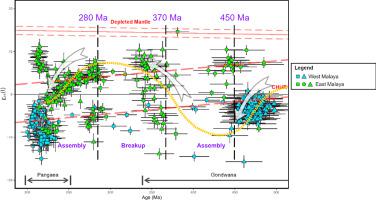Gondwana Research ( IF 6.1 ) Pub Date : 2021-03-05 , DOI: 10.1016/j.gr.2021.03.001 LongXiang Quek , Yu-Ming Lai , Azman A. Ghani , Muhammad Hatta Roselee , Hao-Yang Lee , Yoshiyuki Iizuka , Mohd Rozi Umor , Mark Pecha , Yu-Ling Lin , Rezal Rahmat , Azmiah Jamil

|
The geodynamic process from the evolution of supercontinent has distinct isotope characteristics explorable using zircon Hf isotopic composition. Since Peninsular Malaysia associates with Gondwana dispersal and Pangaea formation, analyzing the U-Pb and Hf-isotopic content of its 500–200 Ma magmatic zircon could reveal the signal left by the transitional geodynamic process between the supercontinents. We collected two groups of magmatic rocks from West Malaya: Ordovician meta-volcanics (n = 8), and Triassic Main Range granitoid province (MRGP) (n = 6); and three groups from East Malaya: Carboniferous meta-volcanics (n = 2), Permian-Triassic Eastern granite province (EGP) (n = 6), and Permian-Triassic EGP volcanics (n = 8). Difference in magmatic zircon Hf isotopic crustal model ages uphold the previous rationale which separates Peninsular into two blocks: West Malaya (part of Sibumasu terrane) magmatic zircon Hf isotopic crustal model ages (Average TDM2: 1.3 Ga) are older than East Malaya (part of Chanthaburi-Sukhothai-Lincang arc of Indochina terrane) (Average TDM2: 0.9 Ga). During the final assembly of Gondwana from 500 to 450 Ma, West Malaya and East Malaya were at the outboard of Gondwana Proto-Tethys margin. The shift of East Malaya zircon Hf array towards higher εHf(t) (external orogenic system) after ca.370 Ma may infers Paleo-Tethys ocean broadening and East Malaya separation from Gondwana. The 370–350 Ma juvenile zircon Hf isotopic composition in East Malaya is a significant improvement over radiolarian age to show the broadening and subduction of the Paleo-Tethys ocean between the two terranes. After ca.280 Ma, East Malaya zircon Hf array shifted towards lower εHf(t) (internal orogenic system). Coinciding with the Indosinian collision at ca.230 Ma, crustal reworking signal increases in both blocks, signifying the end in Peninsular Malaysia Gondwana to Pangaea transitional geodynamic process. As the Paleo-Tethys segment was completely subducted after 230 Ma, the peninsular crustal thickening starts from 230 to 218 Ma. The post-collision phase would begin at ca.215 Ma.
中文翻译:

从冈瓦纳到潘盖亚的马来西亚半岛过渡地球动力学过程:岩浆锆石U-Pb年龄和H同位素组成从500Ma到200Ma的新限制
利用锆石Hf同位素组成可以解释的超大陆演化过程的地球动力学过程具有独特的同位素特征。由于马来西亚半岛与冈瓦纳散布和Pangea形成有关,因此分析其500-200 Ma岩浆锆石的U-Pb和Hf同位素含量可以揭示超大陆之间过渡性地球动力学过程留下的信号。我们从西马来亚采集了两组岩浆岩:奥陶纪超火山岩(n = 8)和三叠纪主山脉花岗岩类省(MRGP)(n = 6);以及来自东马来亚的三组:石炭纪超火山岩(n = 2),二叠纪-三叠纪东部花岗岩省(EGP)(n = 6)和二叠纪-三叠纪EGP火山岩(n = 8)。岩浆锆石Hf同位素地壳模型年龄的差异秉承了将半岛分为两个块的先前原理:西马来半岛(Sibumasu地形的一部分)岩浆锆石Hf同位素地壳模型年龄(平均T DM2:1.3 Ga)比东马来亚(部分)老印度支那地层的尖竹汶-素可泰-临沧弧线)(平均T DM2:0.9 Ga)。在冈瓦纳从500 Ma到450 Ma的最后组装期间,西马来半岛和东马来半岛处于冈瓦纳原始特提斯边缘的边缘。东马来亚锆铪阵列朝向更高ε移位铪(t)(外部造山系统)在大约370 Ma之后可能推断古特提斯海洋拓宽和东马来亚与冈瓦纳的分离。东马来半岛的370-350 Ma锆石Hf同位素组成在放射虫年龄上有了显着改善,显示出两个地块之间古特提斯海洋的扩大和俯冲。ca.280马后,东马来亚锆铪阵列朝向较低偏移ε的Hf(t)的(内部造山系统)。与大约230 Ma的Indosinian碰撞相吻合,两个区块的地壳返工信号均增加,这标志着马来西亚半岛冈瓦纳半岛至Pangea过渡地球动力学过程的结束。由于在230 Ma之后古特提斯段被完全俯冲,半岛地壳增厚从230 Ma开始到218 Ma。碰撞后阶段将从约215 Ma开始。


























 京公网安备 11010802027423号
京公网安备 11010802027423号